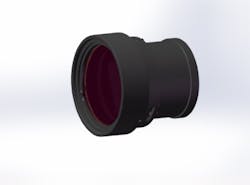Features and Applications of IR Lenses
In order to ensure the seamless functioning of a high-performance optical system, it is essential to establish a foundation comprising suitable mechanical components that are well-maintained and accurately aligned. At Avantier, we have over 20 years of experience in opto-mechanical design. Our mechanical engineers play a key role in your projects by offering optimized and cost-effective designs.
Except for optical software – Zemax, which we have talked about a little bit in other articles, our mechanical engineers will use software like AutoCAD, SolidWorks to work on the mechanical parts. The opto-mechanical design plays a crucial role in the overall process as it provides crucial support to the optics and maintains their performance. During this stage, we carefully integrate all interfaces and consider environmental factors such as vacuum conditions, extreme temperatures, vibrations, and more. By adhering to the specified requirements, we guarantee the system’s technical performance is upheld.
Infrared lenses are crucial components used in various industries for capturing and focusing infrared radiation. They play a vital role in enabling the detection and analysis of thermal energy emitted by objects. In this article, we will explore the features of infrared lenses and their applications in medical instrumentation, life sciences, surveillance, and security and defense.
Infrared lenses are designed to operate in different regions of the infrared spectrum, including short-wave infrared (SWIR), mid-wave infrared (MWIR), and long-wave infrared (LWIR). They are typically made from specialized materials such as germanium, zinc selenide, and chalcogenide glasses that are transparent to infrared radiation.
Medical Instrumentation:
In the field of medical instrumentation, infrared lenses find extensive use in thermal imaging and non-invasive diagnostics. They enable the detection of abnormal temperature patterns, aiding in the identification of diseases and injuries. Infrared thermal cameras equipped with MWIR or LWIR lenses can detect temperature variations on the skin’s surface, helping diagnose conditions such as inflammation, circulatory problems, and cancerous growth. Additionally, infrared lenses are utilized in endoscopic devices for minimally invasive procedures, enabling visualization and precise targeting of internal body parts.
Life Sciences:
Infrared lenses play a significant role in life sciences, particularly in infrared NIR spectroscopy and imaging applications. Infrared spectroscopy involves analyzing the interaction between infrared light and molecules, providing valuable information about their composition and structure. NIR spectroscopy, which operates in the near-infrared (NIR) region, is widely used for chemical analysis, pharmaceutical research, and food quality control. Infrared lenses enable the accurate focusing of NIR light onto samples and detectors, facilitating precise measurements and analysis.
Surveillance:
In the field of surveillance, infrared lenses are utilized for night vision and thermal imaging. SWIR lenses enable enhanced visibility in low-light conditions by detecting light in the 0.9-1.7μm range. This allows for surveillance in complete darkness, making them ideal for military operations, law enforcement, and security applications. LWIR lenses, on the other hand, are employed in thermal cameras, which capture and analyze the heat emitted by objects. This capability is invaluable for perimeter security, detecting intruders, and monitoring critical infrastructure.
Security and Defense:
Infrared lenses have extensive applications in security and defense systems. MWIR and LWIR lenses are crucial components in infrared cameras used for long-range surveillance, target acquisition, and tracking. These lenses enable high-performance thermal imaging, allowing military personnel to detect and identify potential threats, even in challenging environments such as smoke, fog, and darkness. Additionally, SWIR imaging with infrared lenses aids in target recognition and identification by exploiting the reflected SWIR light from objects.
InGaAs sensors are commonly used in conjunction with infrared lenses for imaging and detection in the SWIR region. They offer high quantum efficiency and sensitivity, making them suitable for low-light conditions. Infrared lenses facilitate the precise focusing of SWIR light onto InGaAs detectors, enabling clear and detailed imaging.
In summary, infrared lenses are essential components in various industries. They enable the capture, focusing, and analysis of infrared radiation in the SWIR, MWIR, and LWIR regions. Their applications span medical instrumentation, life sciences, surveillance, and security and defense. Infrared lenses play a crucial role in thermal imaging, night vision, spectroscopy, target recognition, and other critical functions, contributing to advancements in research, diagnostics, and security technologies.
Please contact us if you’d like to schedule a free consultation or request for quote on your next project.

